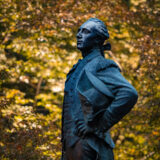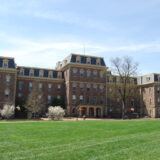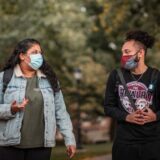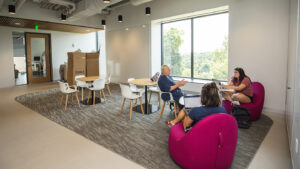Touring Lafayette College
Lafayette is spread across 340 acres, including a 230-acre athletic campus. The 69 buildings compromising 1.76 million square feet of academic, recreational and residential space. There are a variety of different ways that you can experience the Lafayette campus:
Rather than having one dominant architectural style, Lafayette is known for its collection of buildings from a variety of periods and styles from Collegiate Gothic Revial to Beaux-Arts to Romanesque Revival to Modern. Below we highlight some of our most popular buildings. Much of this information has come from the files of our own Professor Robert Mattison, professor of art history, who has a personal interest in architecture and teaches part of the architectural studies minor program.
Pardee Hall
What will I do here? With so many academic programs here, you’ll have at least one class here. There are computer training rooms and a tech lounge on the bottom floor where you can go for computer help.
Scavenger Hunt: On the first floor of the building, walk through to the hallway to experience the display chronicling Washington and David McDonogh’s (mc-DUNN-uh) education at Lafayette, as the College’s first African American students. David McDonogh was the first African American graduate of Lafayette and America’s first black eye doctor.
Selfie Spot: Go to the 4th floor and take your pic with Francis A. March, the first professor of English in the United States.
Architecture Style: Second Empire Style
Architect: John McArthur Jr., who also designed City Hall in Philadelphia.
History: Built in 1871, the front of Pardee Hall faces Easton, rather than the Quad. The firm of Frederick Law Olmstead, American’s first and most famous landscape architect, visited Lafayette in 1909 and suggested reorienting the campus. Lafayette College instituted the American idea of organizing the campus around an open green space, or the Quad. Pardee was rebuilt 1879 and 1897 then renovated 1964-65. Named in honor of industrialist Ario Pardee, Lafayette’s first great benefactor. Thanks to a $20,000 gift from Ario Pardee, Lafayette added civil and mining engineering to its traditional classical curriculum in 1866, becoming one of the first American colleges to address the needs and opportunities created by the Industrial Revolution.
Rockwell Integrated Sciences Center
Academic Programs: Biology, Computer Science, Environmental Science, Environmental Studies
Offices: Dyer Center for Innovation and Entrepreneurship, Hanson Center for Inclusive STEM Education, Office of Sustainability
What will I do here? Study in the open and light-filled study spaces. Grab a smoothie or a grain bowl at the ECO Cafe. Take a lab science to fulfill a Common Course of Study requirement. Put a new business plan or invention into action at the Dyer Center. Find ways to implement more environmentally friendly initiatives at the Sustainability Office.
Scavenger Hunt: Look for the beam which was signed by students, faculty, staff and trustees in 2018.
Selfie Spot: Go to the ground level of the building and take a picture with biology’s gorilla skeleton. Take a picture of the Bushkill River from above in the study space on the 3rd floor
Architect: Payette Architects, Boston
Architectural Style: Modern
History: The curvilinear forms in the interior of the building and pod-like furniture make this a cozy place for students to study. Opened in fall 2019 for classes, the building was named for trustee emeritus Kent Rockwell ‘66, the lead donor of the project. Rockwell earned Platinum LEED Status as a green building project. Watch it being built





